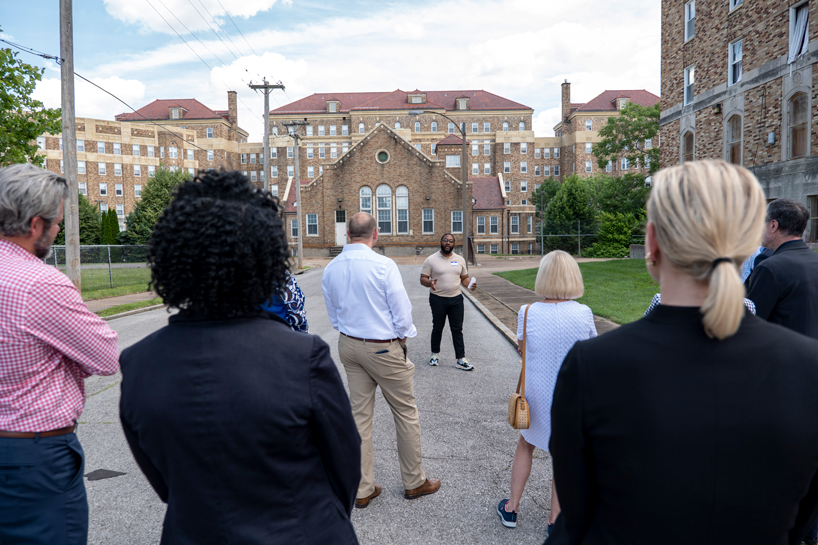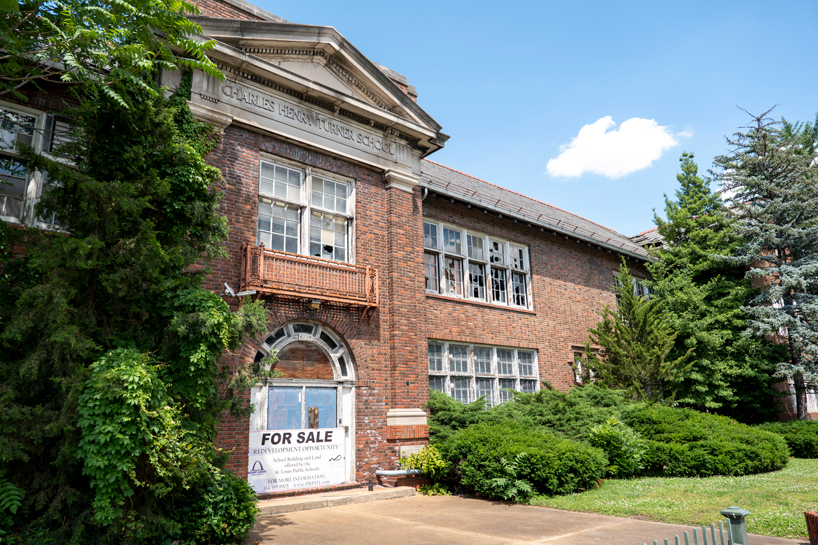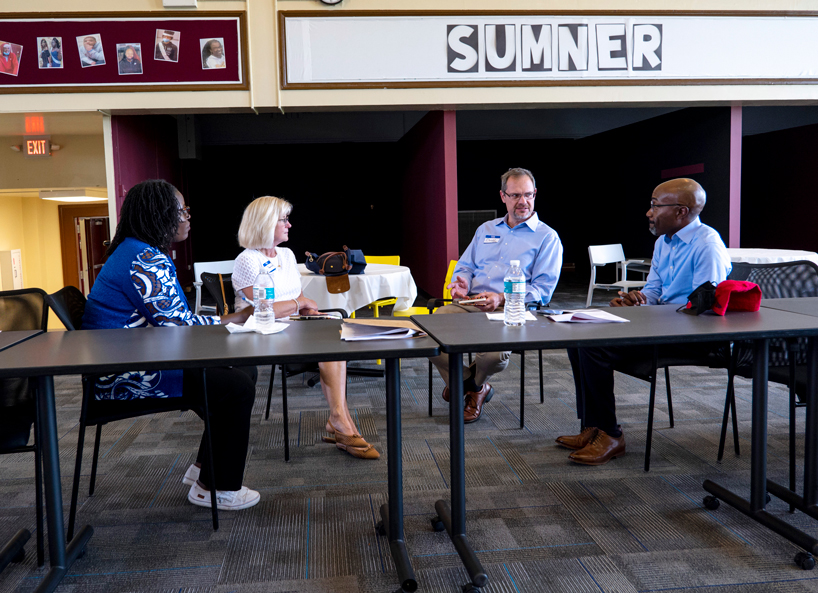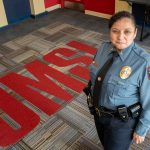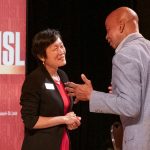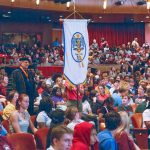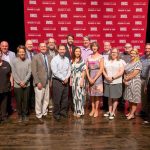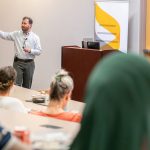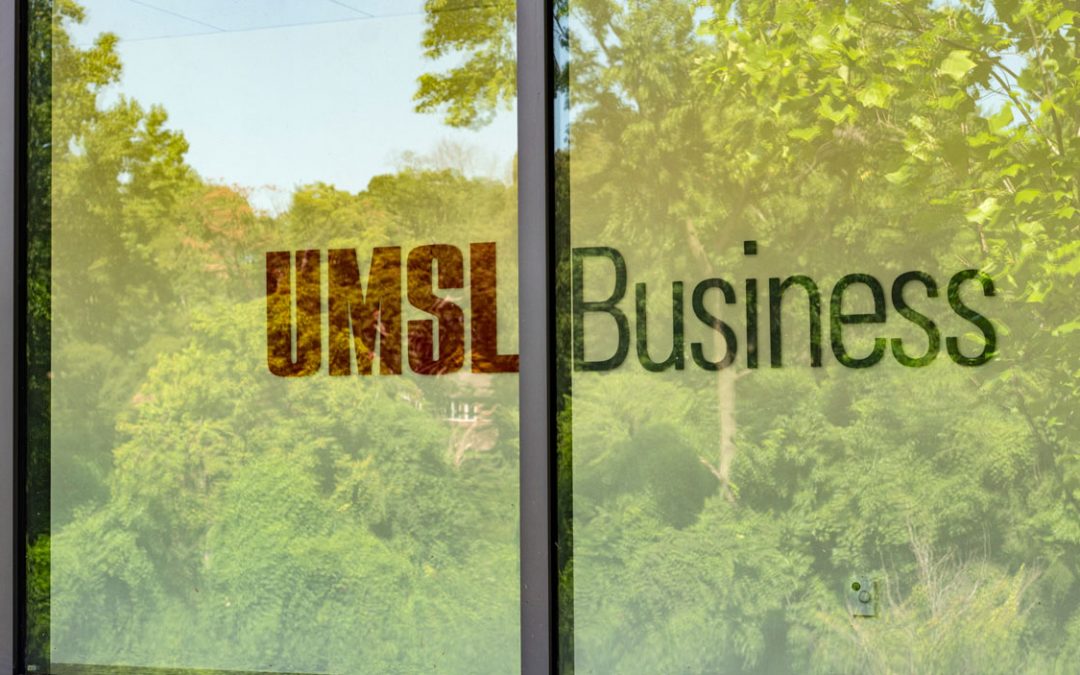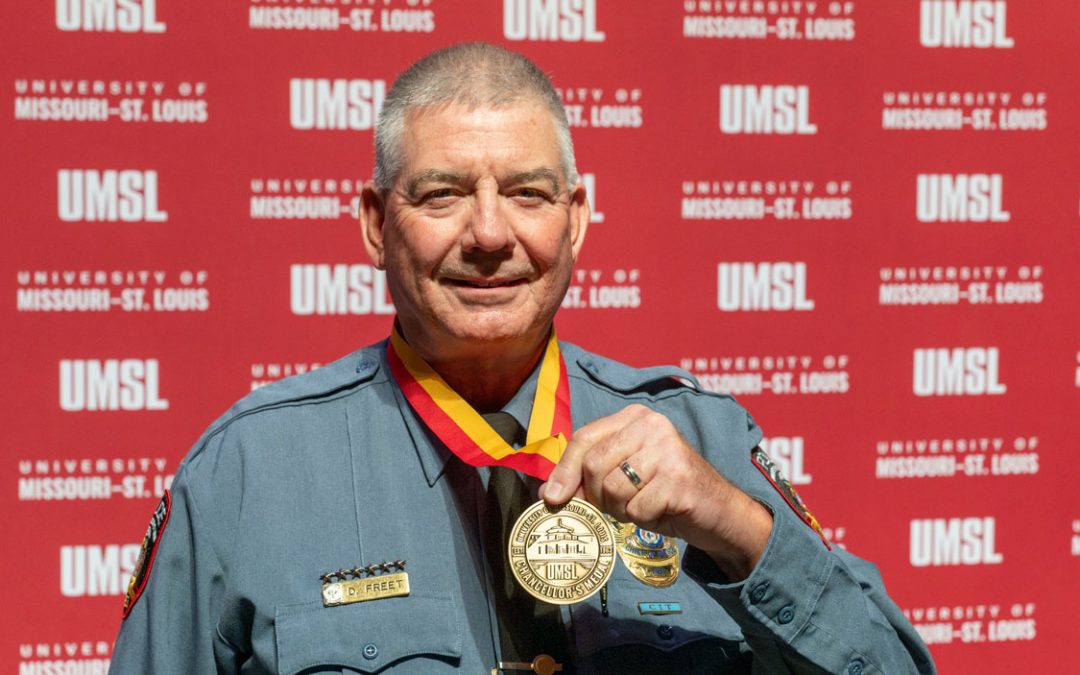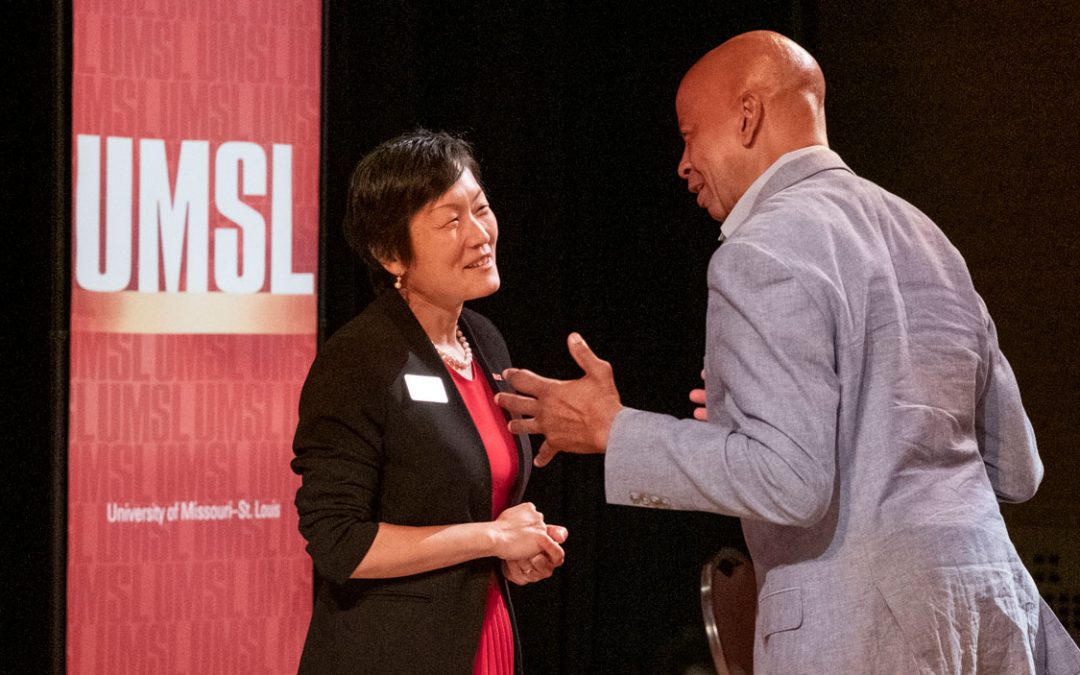
Northside Community Housing President Michael Burns speaks during a panel discussion last week in the library at Sumner High School during the St. Louis Anchor Action Network Executive Learning Experience. (Photos by August Jennewein)
Leaders from the institutions that make up the St. Louis Anchor Action Network gathered in The Ville Neighborhood in north St. Louis last week to learn about the area’s rich history and hear from community leaders about the role network members might play in reversing decades of disinvestment.
The University of Missouri–St. Louis and Edward Jones have been co-leading the development of STLAAN, bringing together leading higher education and health care institutions with some of the region’s top companies and other community partners. They share a commitment to develop and implement successful strategies to address longstanding patterns of inequity in the St. Louis region with a focus on majority Black and Brown communities facing high poverty rates in the City of St. Louis and St. Louis County.
Edward Jones Managing Partner Penny Pennington (center) speaks to attendees of the St. Louis Anchor Action Network Executive Learning Experience in the Sumner High School library. Pennington co-chairs the STLAAN Executive Committee with UMSL Chancellor Kristin Sobolik (at left).
UMSL Chancellor Kristin Sobolik and Edward Jones Managing Partner Penny Pennington, who co-chair STLAAN’s executive committee, welcomed their colleagues to the library of Sumner High School for an Executive Learning Experience last Thursday afternoon.
“We are grateful for the time you have taken to be here today to connect more deeply with the Anchor Network footprint to which we are all committed,” Sobolik said.
“We’re here to listen, to learn, to connect, and then to make commitments through Anchor Action Network, learning together to act together for the needs of our community, as determined by our community, with all of us at the table,” Pennington said. “I do think that it’s a very healthy part of leadership to admit that we have not reached our goal. Nowhere near. Anchor Action Network has not. Edward Jones has not. Our community hasn’t. I have not as a leader. I think it’s very healthy to admit that, to go on a learning journey, to learn what those opportunities and gaps are and then to have the humility to take action toward a better future. That’s what we’re committing to as Anchor Action Network.”
Aaron Williams gave the attendees an introduction to The Ville and its history. He serves as president of the Board of Directors for 4theVille, a community-based tourism and arts organization created by Ville residents and volunteers hoping to restore pride in the legacy of the historic African American community while inspiring reinvigorated community ownership.
Aaron Williams leads a walking tour past Homer G. Phillips Hospital in The Ville neighborhood last week during the St. Louis Anchor Action Network Executive Learning Experience.
Williams is not from The Ville; he grew up across the state in Kansas City near the 18th and Vine district, a vibrant historically Black neighborhood that today is home to the Negro Leagues Baseball Museum and American Jazz Museum.
“Coming from a historic Black neighborhood and understanding how the history and legacy of that neighborhood was embedded into my educational experience, I just couldn’t understand how St. Louis treated The Ville,” Williams said. “Much more historic than the neighborhood that I grew up in but not even close to the level of care.”
Williams led attendees on a walking tour through the neighborhood, past landmarks such as Homer G. Phillips Hospital, the first teaching hospital west of the Mississippi River to serve the city’s Black residents and now a senior living facility; Annie Malone Children and Family Services; Tandy Recreation Center; a football field named in honor of the Tuskegee Airmen, seven of whom graduated from Sumner High School; and tennis courts named in honor of Arthur Ashe.
But Williams also pointed out landmarks that are now gone – schools such as the Charles Turner Open Air School that long ago closed and have fallen into disrepair; Poro College, which served as a training ground for aspiring beauticians; and Stowe Teachers College, which merged with Harris Teachers College in 1954 as the first of several steps to integrate the city’s public schools and left The Ville to consolidate onto the Harris Teachers College campus in Midtown.
The former Charles Turner Open Air School, which opened in 1925 to serve African American children afflicted by conditions such as tuberculosis, now sits vacant and falling into disrepair in The Ville Neighborhood.
Then there is Sumner itself – the first high school for Black students west of the Mississippi that was founded in 1875 and has been in its present location in the heart of The Ville since 1910.
Williams and his colleagues at 4theVille not only want to keep that history alive; they want to ensure that The Ville doesn’t meet the same fate as other historically Black neighborhoods in the St. Louis region, including Mill Creek Valley, Kinloch and Brooklyn, Illinois.
After the walking tour and some time for reflection, Williams moderated a panel discussion featuring Michael Burns, president of Northside Community Housing; Thomasina Clarke, co-founder of 4theVille; Rev. Clyde Crumpton of Cote Brilliante Presbyterian Church; Tom Ridgely, the producing artistic director at St. Louis Shakespeare Festival; and Kevin Wilson, executive director of Small Business Empowerment Center. They talked about the work they are doing to either protect, restore or transform The Ville neighborhood and strengthen it for the future.
Crumpton gave an impassioned speech about the importance of using the past to inspire that future.
“When we tell our story and know our history and our culture, which is very rich, it builds pride, self-esteem and value, and that’s what our children need,” Crumpton said. “That’s one of the components that’s missing. Once they know and are exposed to history – and their responsibility to protecting and teaching and building it – it takes us to the level where we want to go as a community and as a people.”
(From left), Washington University Executive Vice Chancellor for Administration Shantay Bolton, Gateway Greenway CEO Susan Trautman and Saint Louis Zoo President and CEO Dwight Scott listen as Jason Purnell, BJC’s vice president for community health improvement, makes a point during a small group discussion at Sumner High School.
Network members hope to play a role in creating that future by consciously taking steps to increase hiring and purchasing from not only The Ville but 22 zip codes across the St. Louis region. They recognize that investments have to be guided by the people living and working in those communities, which is one reason why last week’s experience was so important.
“I just want to offer to you my gratitude and thanks for going on this journey with me today,” St. Louis Anchor Action Network Director Stefani Weeden-Smith said before dismissing attendees to dinner provided by Sweet Tooth Barbecue. “We had lots of amazing touch points I hope that you will continue to take with you. I hope you will continue to tell the story of The Ville in your institutions and the folks that you see in St. Louis and keep it alive and really look toward the future of what this neighborhood could be.”


